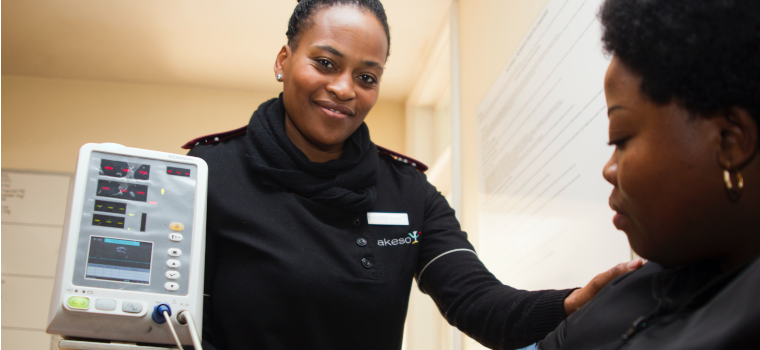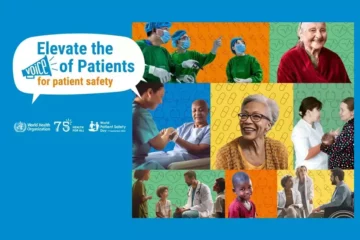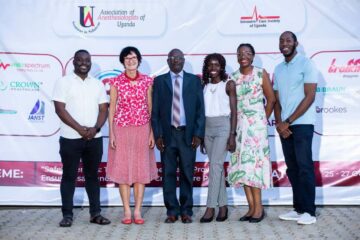In March of 2020, Chimére Smith, then a 37-year-old middle school teacher in Baltimore, went to see her doctor about a sore throat, dizziness, shortness of breath and gastrointestinal issues — all signals well-recognized today as possible symptoms of COVID-19.
But her doctor sent her home, she says, told her to take it easy and that she’d likely feel better in a couple of weeks. Her symptoms only got worse.
For five months that spring and summer, Smith says, that primary care physician and other specialists she spoke with ignored her laundry list of escalating physical symptoms: a brain that felt like it was on fire, numbness and weakness in arms and legs, so severe she had trouble standing and eventually had trouble walking.
“I saw many emergency doctors that included doctors who were managing Johns Hopkins’ emergency room department at the height of the pandemic during the first wave of COVID”” Smith says. “he refused to acknowledge many of my symptoms and sign any documents that supported my disability.”
Some doctors suggested the Baltimore school teacher get a psychiatric work-up, instead of more physical tests.
More than a dozen doctors’ visits, including to some of the best and brightest neurologists in Baltimore, made her feel like she was going crazy and knew nothing about her own body. Still, she knew something was seriously physically amiss. Smith felt “left for dead.”
As it turns out, she was suffering from what has since become a well-recognized, if still ill-defined syndrome: long COVID. Also known as “COVID long-haulers,” these are patients whose symptoms related to an infection with the coronavirus persist for months. And while many patients have struggled to get an accurate diagnosis for symptoms that can seem like a grab bag of unrelated conditions to a clinician pressed for time, Smith had reason to think she was being dismissed more quickly than others.
“I was racially profiled for complaining of a burning brain,” the Black middle school teacher from Baltimore told Congress at a hearing on Long-Covid last April. “As a black woman who grew up in Black urban neighborhoods, we have a fear of going to doctors because of the historical background.” Despite this, she felt confident going to the doctor and navigating the medical space since something was wrong. Yet, she says, doctors humiliated her, dismissed her, and even turned her away. Some doctors assumed her symptoms were psychiatric, not physical, or even that her long COVID symptoms were a side effect of recreational drugs. “I can paint a picture of humiliation, degradation, feeling like my voice and my health did not matter,” she says regarding seeking treatment for long COVID. Yet, she persisted, repeating her symptoms to doctors at each visit. “Something inside of me said ‘push through this’ … someone will have to hear me, listen to me, and acknowledge what I’m experiencing. This is not common, this is very bizarre – and I was very sick.”
Despite having health insurance, she lost her life savings – and eventually her job-seeking care. Bed-bound and unable to drive, Smith depended on grocery delivery services to purchase electrolyte drinks for extreme dehydration, eye drops for dry eye caused by inflammation, as well as vitamins recommended by other Long Haulers. She also spent money on car payments, health insurance, monthly bills, medical copayments, visits to the emergency room, and medications she was prescribed. As Smith explained via email: “As I have not worked or been paid in over a year, I used all of my savings to cover these costs. I also received help via crowdfunding and donations from my family and friends. Had I not received these, I would be without food, a car, or home. I am now receiving very little government assistance and awaiting disability insurance.”
Smith’s experience is just one of many exemplifying the ways racial prejudice has continued to harm patients of color and other frequently marginalized groups during the pandemic, says Ellie Reyes, a nurse, consultant on health care diversity and inclusion, and founder of the Inclusive Care Project.
“Our work and identities [as health care professionals] are entrenched in … being healers,” Reyes says, “but we’re also causing and perpetuating harm.”
Discrimination impedes an already-complex COVID-19 long-haul diagnosis. For almost 15 months into the pandemic — until June of this year — doctors lacked formal guidelines for diagnosing long COVID. The U.S. Centers for Disease Control and Prevention finally published its guidance on June 14. Smith helped write that guidance, describing it as “some of the most important documentation that we’ve seen with long COVID,” especially for diagnosing historically marginalized patients. Having concrete guidance on how to diagnose and treat long COVID can help reduce medical racism, by providing diagnostic tools that can allow doctors to focus on improving the standard of care for minorities. “People of color, people in underserved areas experience more health disparities – their issues need to be considered even more.“
COVID long-hauler Hannah Davis is co-founder of the Patient-Led Research Collaborative. She also helped write the CDC guidelines. Davis calls the undiagnosed long-haulers’ experience a “triple whammy”: They don’t get treatment, she notes, and since they haven’t been formally diagnosed, they can’t participate in research studies on COVID long-haulers, so continue to remain invisible to the scientific community. They also can’t take sick days from work to rest — the main treatment for long-haulers at the moment, since both physical and cognitive exertion can trigger long COVID symptoms.
Smith’s primary care doctor seemed imperious and disbelieving, so she fired him. She says she “got lucky” finding two other caring doctors — both Black — who both took time to listen to her, she says, looked at the same test results, and took her symptoms seriously. Ultimately she was, indeed, diagnosed as having long COVID. She sat and discussed her situation with these doctors whom she found by happenstance, one from ZocDoc, and one at Johns Hopkins University. She says she never had to prove herself to them; they engaged her in a conversation and tried to understand her medical history. Unlike her previous experiences, she didn’t have to arrive at the doctor’s office with a bunch of paperwork. She told them her story and asked: “Can you help my brain stop burning, because it’s been burning for the past four months.” Both doctors said that she had a suspected case of post-COVID syndrome. She had been looking for doctors who believed her and championed her over the past several months. “A doctor finally sat with me and said, ‘I believe you,’” says Smith. “We need more Black doctors,” she adds.
She likens health disparities to educational disparities. “Historically,” Smith says, “there is a missing piece in how Black people are treated, and how they are helped and healed.” In her previous work as an educator, Smith helped her students become high achievers. “When Black children have Black teachers, there is a higher range of success,” explains Smith. Research shows that having same-race role models early on can help Black students not only complete high school but also go to college. What’s more, research shows that improved educational outcomes also typically lead to improved health, except for Black men. When Black patients (including Black men) see Black doctors, they are more likely to adhere to their doctor’s recommendations for lifesaving preventative care.
An understanding of one’s background and culture — what’s known as “cultural competency” — plays an important role in health care as well. In the 17th century, community midwives served pregnant Black, indigenous, and immigrant women. Midwives apprenticed informally and understood the culture and traditions of their patients. In the 1920s, new midwife licensing eliminated the apprenticed midwives. Nowadays, pregnant Black women often choose to escape at least one aspect of racism in their obstetrics care by choosing Black doctors.
Dr. Amanda Calhoun is a medical resident in psychiatry and PhD candidate in public health at Yale. Her doctoral research is examining the ways racism impacts Black American girls’ mental health. She’s finding that racism leads to clinical decision-making that leads to poor patient care: as she tells me, “It starts with how patients are described.” Doctors may describe white patients as “struggling or upset,” she says while noting identical behavior in Black patients as “aggressive and violent.”
Medical diagnostics may look “objective,” but they can include baked-in racism, researchers have noted. For example, race factors into kidney function measurement, so Black patients are less likely to receive a kidney transplant than white patients. As a result, while Black Americans constitute more than one-third of dialysis recipients, they only receive one in five of every kidney transplants.
False beliefs about pain tolerance mean that some doctors underprescribe painkillers to Black patients. In December of 2020, Dr. Susan Moore, a Black physician hospitalized for COVID-19 took to Facebook with a video recorded on her smartphone that went viral, detailing her white doctor’s disparagement of her COVID-related pain, and reluctance to offer medication to relieve it, despite her repeated requests.
“I was crushed,” Moore said in the video. “He made me feel like I was a drug addict. And he knew I was a physician. I don’t take narcotics. I was hurting.”
After asking to be transferred to another hospital, she was ultimately discharged – and soon readmitted to another ICU, where she died.
Calhoun says calling out racism in the health care sphere is “very tricky”, even for medical professionals, “and depends on the space that you are in.” She might say something like, “Why did you describe the patient as violent or oppositional when the other patient that was doing similar behavior was not?” Still, she says, sometimes her colleagues criticize her for speaking up.
Hospital hierarchies typically value seniority over experience. In the clinic, an attending physician oversees doctors-in-training: residents, interns, and medical students. Attendings are decision-makers. Observations from junior colleagues — including from medical residents, such as Calhoun — often go ignored.
Patients, too, can remain unheard, Calhoun notes. They may lack medical knowledge or ignore gut feelings that something is wrong, so they may not speak up. And when patients do speak up, doctors may dismiss their complaints.
There’s also an entire documentary series being produced about discrimination in medicine, called Standard of Care. “We need to be able to talk about [these problems] to begin fixing them,” says director Nancy Pickett. The film series tackles barriers to care including racism, criminal history, immigration status, socioeconomic standing, location, age, mental health, gender identity, and weight.
One way to reduce discrimination in medicine, experts say, is for hospitals, clinics and other medical groups to cultivate the attributes of a high-reliability organization, or HRO, loosely defined as “organizations that operate in complex, high-hazard domains for extended periods without serious accidents or catastrophic failures.”
A classic example of an HRO can be found in the airline industry. Airplane pilots, for example, are tasked with long checklists to make sure everything goes well on their flight, because not following the rules can lead to disaster. Similarly, a doctor’s office that functions as an HRO does “everything by the book,” says Dr. Ramsay. That includes things like maintaining cleanliness, washing hands, and, in the COVID-19 pandemic, masking and maintaining social distancing. “You’ll see it right away — does the doctor arrive on time? Does the staff know precisely what to tell you? Are they ignoring you? Are they not really talking directly to you? Do they check that the information that you’ve got is the right information when you leave the office?”
The nonprofit Patient Safety Movement Foundation (PSMF) estimates that medical errors kill 3 million people worldwide each year. “Our hospitals must become high-reliability organizations where there is zero harm,” says Dr. Michael Ramsay, a retired anesthesiologist and PSMF’s CEO.
PSMF’s Actionable Patient Safety Solutions(APSS) is a free, comprehensive patient safety curriculum. Its checklist-style protocols for hospital procedures resemble airplane pilot procedures. The APSS also tackles cultural aspects of patient care. They discuss the importance of a culture of communication, in which both patients and healthcare workers are able to voice their concerns and break out of a toxic culture of silence and fear. The PSMF writes on their website, “Organizations must have a strong foundation before reliable systems of care can be established for specific populations.” Modeling health care after HROs can help reduce harm by standardizing the way care is provided, and identifying and mitigating sources of bias that can disenfranchise marginalized patients.
Where does eliminating medical racism fit into HROs? You’ve got to “walk the walk,” says Dr. Ramsay. PSMF has two APSS guidelines in the works tackling racism:cultural competency in care, and another addressing structural determinants of racism, coming in Fall 2021. “If you’re going to be a diverse, equal opportunity organization: demonstrate it. People will walk in and see it immediately. Vision and optics and actions are much louder than words. You can claim to be all kinds of things, but as soon as someone looks at you and what you’re doing and looks at your organization, they can see what you’re really doing.”
Without efforts to make hospitals run more like HROs, the healthcare system will continue to disenfranchise minoritized people. In the words of Chimére Smith, the Baltimore teacher who testified before Congress last spring: “I thought my little blue insurance card would get doctors to at least hear and listen to my symptoms…that thinking was completely shattered.”





